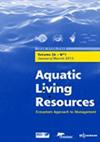Model selection for fish growth patterns based on a Bayesian approach: A case study of five freshwater fish species
IF 1.5
4区 农林科学
Q3 FISHERIES
引用次数: 4
Abstract
Selecting an appropriate growth pattern for individual fish is a meaningful but complex topic in fishery research. We model four growth functions − the commonly used von Bertalanffy growth model (VBGM), and the Gompertz growth model (GGM), Schnute–Richards growth model (SRGM), and generalized VBGM (G-VBGM) − to examine possible growth patterns. Mean total length-at-age fish datasets for five commercial fish species (yellow perch Perca flavescens, walleye Sander vitreus, northern pike Esox lucius, largemouth bass Micropterus salmoides and lake herring Coregonus artedi) from North American freshwater ecosystems, were analyzed. Using a Markov chain Monte Carlo (MCMC) algorithm, we structured four models combining informative priors of model parameters. It is the first time that deviance information criterion (DIC) and leave-one-out cross-validation (LOOCV) were combined to select the best growth model. During the model-selection process, the smooth LOOCV error successfully followed the trend of the LOOCV error, although there were difference in the curve shapes. Values of scale reduction factor (SRF) for all four models indicated convergence, ranging 1.02–1.06, below the 1.2 threshold. The GGM was selected for C. artedi, and the G-VBGM for the other four species. Our approach provided a robust process in model-selection uncertainty analysis, with the G-VBGM having the best prediction ability among our datasets.基于贝叶斯方法的鱼类生长模式选择——以五种淡水鱼为例
为个体鱼选择合适的生长模式是渔业研究中一个有意义但又复杂的课题。我们建立了四种生长函数模型——常用的von Bertalanffy生长模型(VBGM)、Gompertz生长模型(GGM)、schute - richards生长模型(SRGM)和广义VBGM (G-VBGM)——来检验可能的生长模式。对北美淡水生态系统中5种商业鱼类(黄鲈、白眼沙鲈、北梭子鱼、大口黑鲈和湖鲱鱼)的平均总体龄数据进行了分析。利用马尔可夫链蒙特卡罗(MCMC)算法,结合模型参数的信息先验构造了4个模型。这是首次将偏差信息准则(DIC)和留一交叉验证(LOOCV)相结合来选择最佳增长模型。在模型选择过程中,平滑LOOCV误差成功地跟随了LOOCV误差的趋势,尽管曲线形状存在差异。4个模型的尺度缩减因子(SRF)值均在1.02 ~ 1.06之间,均低于1.2的阈值。结果表明,黄花蒿选择GGM,其余4种选择G-VBGM。我们的方法在模型选择不确定性分析中提供了一个稳健的过程,其中G-VBGM在我们的数据集中具有最佳的预测能力。
本文章由计算机程序翻译,如有差异,请以英文原文为准。
求助全文
约1分钟内获得全文
求助全文
来源期刊

Aquatic Living Resources
农林科学-海洋与淡水生物学
CiteScore
2.30
自引率
0.00%
发文量
10
审稿时长
>24 weeks
期刊介绍:
Aquatic Living Resources publishes original research papers, review articles and propective notes dealing with all exploited (i.e. fished or farmed) living resources in marine, brackish and freshwater environments.
Priority is given to ecosystem-based approaches to the study of fishery and aquaculture social-ecological systems, including biological, ecological, economic and social dimensions.
Research on the development of interdisciplinary methods and tools which can usefully support the design, implementation and evaluation of alternative management strategies for fisheries and/or aquaculture systems at different scales is particularly welcome by the journal. This includes the exploration of scenarios and strategies for the conservation of aquatic biodiversity and research relating to the development of integrated assessment approaches aimed at ensuring sustainable and high quality uses of aquatic living resources.
 求助内容:
求助内容: 应助结果提醒方式:
应助结果提醒方式:


